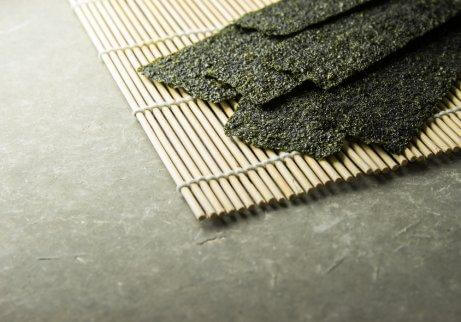How to Consume Seaweed and its Nutritional Value

You’ve surely read recipes that include seaweed and you probably wondered how to consume seaweed and where you can buy it. In this article, we’ll talk about how to consume seaweed and the nutritional value of this ingredient that’s becoming increasingly popular in gastronomy.
Different Types of Edible Seaweed

Nowadays, seaweed can be found in many dishes around the world.
The first thing you should know before you consume seaweed is that it can be divided into three main groups: brown algae, red algae, and blue-green algae.
Brown algae
- Nori include laver, sloke, ova marina and slake. They’re rich in proteins and vitamin A and can be combined with fried foods.
- Nishime Kombu include carweed, tangle, and wrack. They provide potassium and iodine and make foods sweet.
- Ito wakame: You can combine it with cooked vegetables and it provides calcium, vitamins B and C, and potassium.
- Hiziki goes well with root vegetables such as carrots or beets. It contains a lot of potassium, calcium, and iron.
- Arame is soft and light. It’s rich in iodine and calcium.
- Alaria includes dabberlocks, murlins, and winged kelp. It’s rich in minerals and vitamins and is used to prepare soups.
Red algae
- Dulse goes well with cooked grains and provides iron, phosphorus, and potassium.
- Agar includes shiro kanten. It’s a very nutritious jelly-like substance that contains a lot of fiber.
- Carrageen moss is also called Irish moss. It contains a lot of complex carbohydrates, as well as calcium and potassium.
Blue-green algae
- Spirulina is rich in amino acids and proteins and is sold in tablets or powder. It can be added to cereals, yogurt, juice, or milk.
This article may also interest you: How Spirulina Can Help You Lose Weight
Tips for Preparing Seaweed

It’s advisable to soak the seaweed before consuming it.All seaweed, regardless of the group it belongs to, should be soaked for at least 20 minutes so it grows up to seven times its size and volume.
If it’s overly salty or sandy, wash it with cold water.
Blue-green algae, when soaked, can be cut into strips in the same direction as its growth. Red algae can be chopped or cooked whole. Agar can be cut before or after being cooked.
Cooking Tips
- Wakame, nori, chlorella, kelp, spirulina, and dulse can be eaten raw.
- Kombu seaweed requires at least 45 minutes of soaking and then half an hour of cooking. The resulting broth can be used to make soups or sauces or to cook vegetables.
- Hijiki seaweed is best during the winter months and has a very strong flavor. You can use this seaweed to make soups, stews, and puddings. You must soak it for 30 minutes and then cook it for the same amount of time. Reheating it isn’t recommended.
- Although you can use wakame to prepare dozens of dishes, it’s the quintessential ingredient of miso soup. You need to soak wakame for 15 minutes and cook it for 10. You can also eat it raw in salads.
- Nori doesn’t need to be soaked. You can toast it on a frying pan until it turns gold or green. Then, cut it into pieces with scissors and grind them by hand (when they’re warm). You can add nori to soups or cereals.
- Kanten seaweed is mainly used in cold sauces, creams, puddings, salads, or to thicken soups and stews.
This article may also interest you: How and When to Take Spirulina for it to be More Effective
Reasons Why You Should Consume Seaweed
1. Edible seaweed is nutritious.
- It’s good for diabetics. Since it contains complex sugars, it doesn’t raise blood sugar levels.
- Seaweed is great for vegetarians because it contains a lot of protein. Spirulina contains more protein than eggs, fish, and meat.
- Edible seaweed covers the body’s daily iron requirements. This is epecially true with spirulina, which contains about six times more than cereals and spinach. It’s good for anemia or general weakness.
- Edible seaweed can help fight hypertension. It regulates the cardiovascular system and helps fight high blood pressure.
2. It keeps your body healthy.
- Seaweed improves eyesight because it’s high in vitamin A. Nori and spirulina are recommended for this purpose.
- It can calm a cough. Edible seaweed is also very good for curing colds and flus. In traditional medicine, it’s used as a respiratory system syrup by mixing it with honey and lemon juice.
- Edible seaweed keeps the skin and hair healthy due to the vitamin A it contains (more than wheat germ), known as the beauty and longevity vitamin. Some seaweed also contains zinc, effective for the treatment of acne. Other types make hair shiny.
- It’s good for your bones and teeth. Arame seaweed contain 15 times more calcium than milk. As well as spirulina and wakame, arame seaweed is recommended for the prevention of osteoporosis or to help mend a broken bone.
3. It’s great for your digestive system.
- Seaweed aids digestion and intestinal transit if consumed along with legumes due to its fiber content. The same goes when you consume seaweed with fried foods because it improves digestion.
- It cleans the intestines. Seaweed purges this organ due to the alginic acid it contains. It removes toxins that are deposited in the colon wall. It’s also used as a natural remedy for colitis.
- Seaweed lowers cholesterol levels because it contains 5% unsaturated fats that lower “bad” cholesterol levels. Also, it doesn’t contain saturated fats.
Thanks to the many benefits we’ve mentioned in this article, you should definitely start consuming seaweed more frequently. You can include it in your traditional dishes or create unique recipes.
This text is provided for informational purposes only and does not replace consultation with a professional. If in doubt, consult your specialist.








